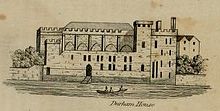- Durham House (London)
-
Coordinates: 51°30′32″N 0°7′24″W / 51.50889°N 0.12333°W
Durham House, or Durham Inn, was the historic London residence of the Bishop of Durham in the Strand, with its gardens descending to the Thames.
Contents
History
Origins
Bishop Thomas Hatfield built the opulent Durham House circa 1345; it had a large chapel and a high-ceilinged hall supported by marble pillars. On the Strand side its gatehouse led to a large courtyard. The hall and chapel faced the entrance, and private apartments overlooked the river.
Accounts describe Durham House as a noble palace befitting a prince. Henry IV, his son Henry, Prince of Wales (later Henry V), and their retinues stayed once at the residence.
Tudor and Jacobean era
Durham House remained an episcopal palace until Bishop Cuthbert Tunstall relinquished it to Henry the Eighth, who vowed to give the Bishop Coldharbour and other residences in return but never honoured that promise. Henry in turn granted Durham House to his daughter Elizabeth for life, or until she was otherwise advanced. Later, Henry's son Edward confirmed the grant, and thereby deprived Tunstall of his see. However, Mary relinquished the house from Elizabeth's possession to Tunstall, along with his see, upon her accession, for it had become apparent Tunstall no longer had a London residence.
Mary's predecessor, Lady Jane Grey, the "Nine Days" Queen of England, was married at Durham House on May 21 or 25, 1553 to Guilford Dudley.
Upon her accession, Elizabeth seized possession of Durham House again, and deprived Tunstall of his see; she kept possession of the residence until 1583, when she granted it to Sir Walter Raleigh. Raleigh spent £2000 on repairs and lived there until Elizabeth's death. John Aubrey said that he well remembered the room which Raleigh used as his study; it was in a little turret that looked over the Thames and had a view of Westminster, Whitehall Palace, and the Surrey hills.
It was in Durham House that Raleigh hosted Manteo and Wanchese, the first Native American Algonquin Indians to travel to England from the New World. In 1584 Sir Walter Raleigh had dispatched the first of a number of expeditions to Roanoke island to explore and eventually settle the new land of Virginia. Early encounters with the natives were friendly, and, despite the difficulties in communication, the explorers were able to persuade "two of the savages, being lustie men, whose names were Wanchese and Manteo" to accompany them on the return voyage to London, [1]
Once safely delivered to England, the two Indians quickly made a sensation at court. Raleigh's priority however was not publicity but rather intelligence about his new land of Virginia, and he restricted access to the exotic newcomers, assigning the brilliant scientist Thomas Harriot with the job of deciphering and learning the Carolina Algonquian language. [2], using a phonetic alphabet of his own invention in order to effect the translation.
Upon Elizabeth's death and Raleigh's resulting loss of influence at court, Tobias Matthew, then bishop of Durham, reclaimed Durham House for the see of the Privy Council. The new king, James I, approved the move.
Decline
Neither Matthew nor any of his successors resided in Durham House, and it became dilapidated as a result. The stables were demolished for construction of the New Exchange, a market which was occupied by milliners and sempstresses in shops along upper and lower tiers on each side of a central alley. However, in the 1630s it was the setting for the Durham House Group, including Richard Neile, William Laud and other high church Anglicans.
The best portion of the house was tenanted by Lord Keeper Coventry, who died there in 1640. What remained of the house was subsequently obtained by Philip Herbert, 5th Earl of Pembroke. He rented it from the see for £200 per year and intended to build a fine house on the site, but never did. Instead, he made Durham Street, which ran through the old remains down to the river and whose upper portion at the Strand end still exists. It is a short, steep street that descends under the Society of Arts and disappears in the gloom of the dark arches of the Adelphi.
The last portion of the ruins was cleared away early in the reign of George III, when the brothers Robert Adam and James Adam built the Adelphi Buildings, raising the whole level on lofty arches.
Notes
Source
Bibliography
- Borer, Mary Cathcart. The City of London: A History. (NY: McKay, 1977) (pp 157)
- Milton, Giles, Big Chief Elizabeth - How England's Adventurers Gambled and Won the New World, Hodder & Stoughton, London (2000)
- Stone, Lawrence. Family and Fortune: Studies in Aristocratic Finance in the Sixteenth and Seventeenth Centuries. (Oxford: Clarendon, 1973) (pp 96-97, 100, 103)
- Stow, John A Survey of London. Reprinted from the Text of 1603. Ed. Charles Lethbridge Kingsford. 2 vols. (Oxford: Clarendon, 1908) (2:400)
See also
Other Strand mansions:
Categories:- Episcopal palaces of the bishops of Durham
- Episcopal palaces in London
- Former houses of Westminster
Wikimedia Foundation. 2010.


